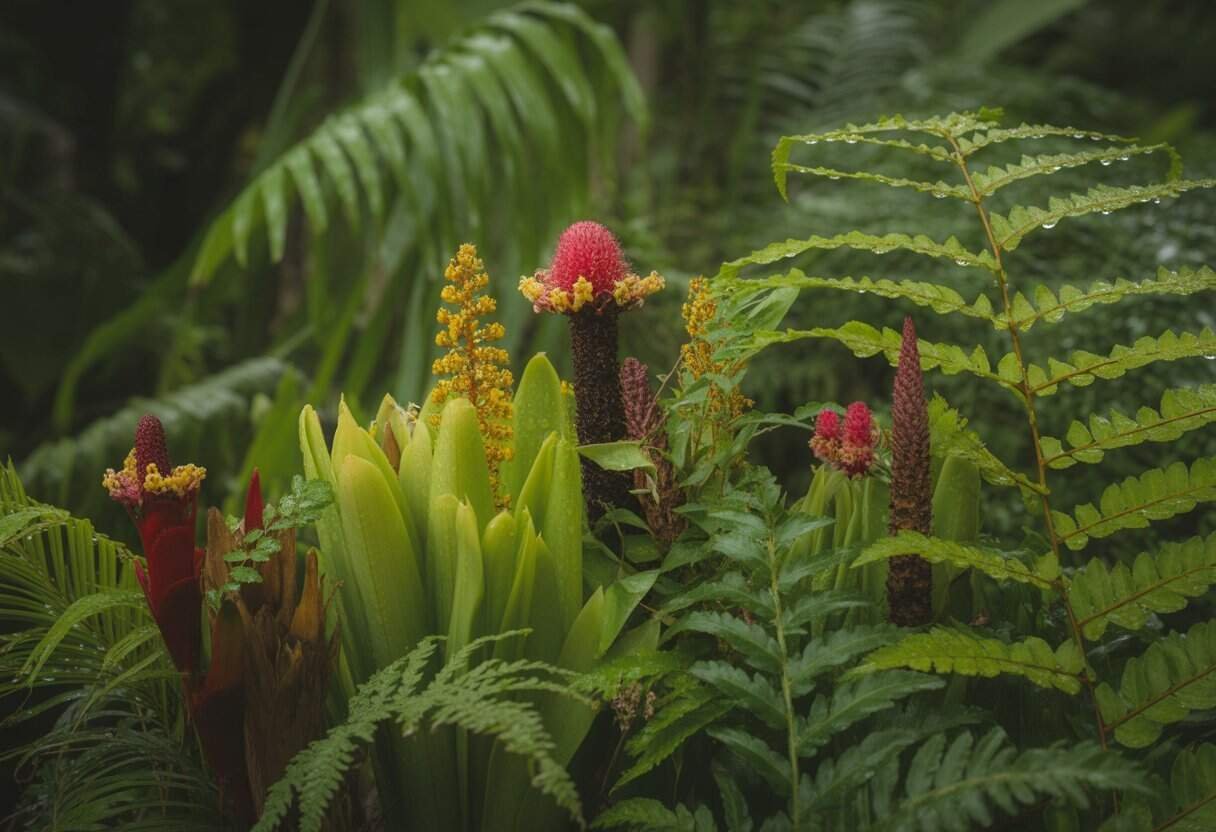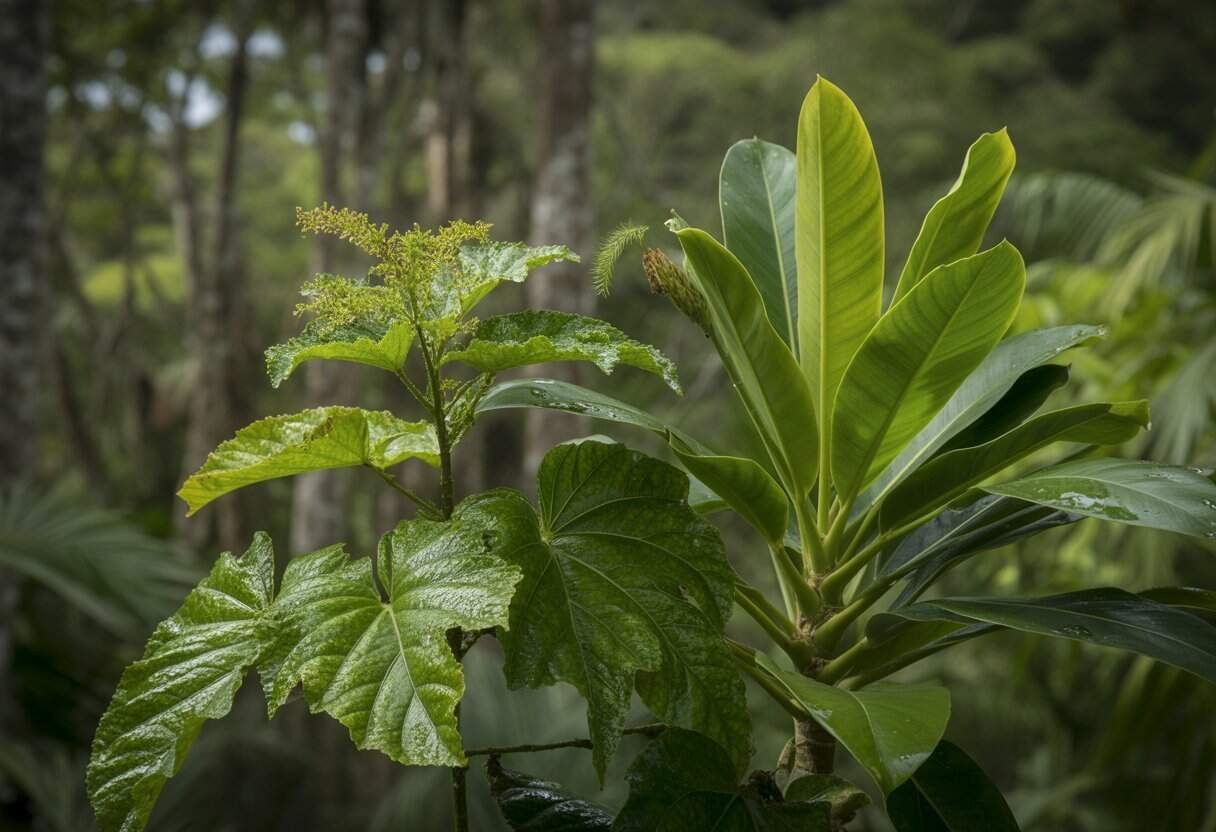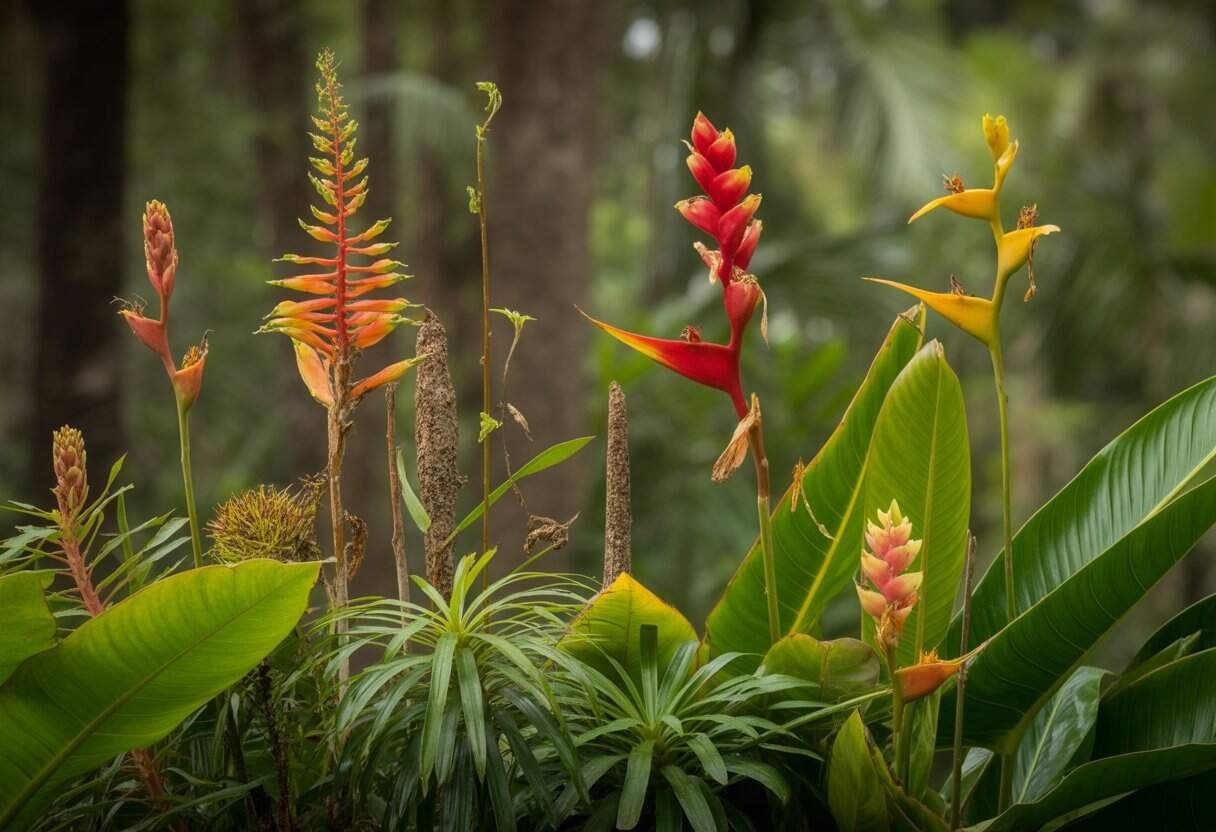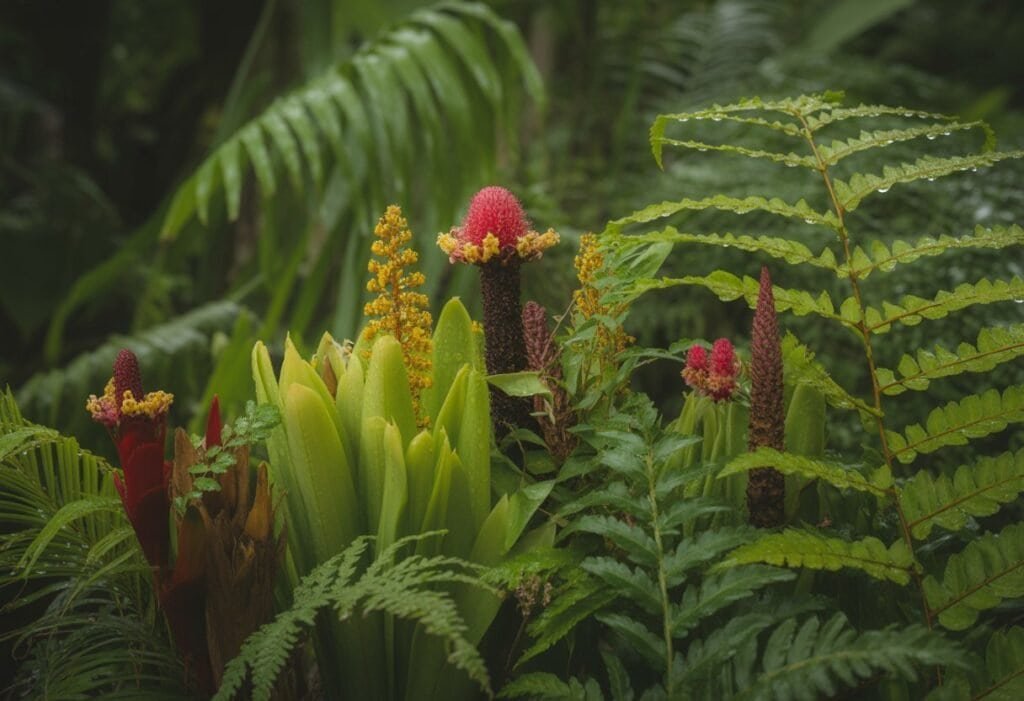Hawaii’s volcanic islands are home to some of the world’s most extraordinary plant species. These rare native Hawaiian plants evolved in isolation over millions of years.
Today, over 1,200 native plant species exist in Hawaii. Approximately 90% are endemic, meaning they grow naturally only in the Hawaiian archipelago.

These botanical treasures range from the silversword, which looks like a spiky silver globe, to the colorful ‘ōhi’a lehua with its bright red brush-like flowers. Many rare Hawaiian plants have adapted to thrive in specific microclimates, from misty mountain forests to dry coastal areas.
This specialization makes them especially vulnerable to environmental changes. Many of these unique plants face serious threats from habitat loss, invasive species, and climate change.
Some, like the Cyanea superba (hāhā), dropped to fewer than 20 individuals in the wild before conservation efforts began.
Key Takeaways
- Hawaii hosts over 1,200 native plant species with an extraordinary 90% endemism rate, making its flora among the most unique on the planet.
- Rare Hawaiian plants have evolved remarkable adaptations to specific island environments, from drought tolerance to specialized pollination relationships.
- Conservation efforts through seed banking, habitat restoration, and invasive species control are critical for saving Hawaii’s endangered plant species.
Overview of Rare Native Hawaiian Plants
Hawaii’s unique geography has created a botanical treasure trove of rare native plants found nowhere else on Earth. These plants evolved in isolation and developed distinctive characteristics.
They form vital components of Hawaii’s delicate ecosystems.
Definition and Criteria for Rarity
A rare native Hawaiian plant is a species with a small population, a restricted geographic range, or significant threats to survival. Scientists consider Hawaiian plant taxa rare when they exist in fewer than 50 natural occurrences or have fewer than 3,000 individual plants in the wild.
Scientists classify Hawaiian plant rarity using several factors:
- Population size: Number of individual plants still existing
- Geographic range: Limited to a single island or specific habitat type
- Threat level: Vulnerability to extinction due to environmental or human factors
Over 40% of Hawaii’s native flora is listed as rare, endangered, or threatened. This high percentage reflects both Hawaii’s unique evolutionary history and the severe impact of modern threats.
Native plants like the Mauna Loa silversword (Argyroxiphium kauense) show this rarity, with fewer than 1,000 individuals left in specialized alpine habitats.
Importance to Hawaiian Ecosystems
Rare native plants are irreplaceable in Hawaiian ecosystems. Many rare species act as keystone plants, supporting many other organisms through complex ecological relationships.
These indigenous plants provide:
- Habitat for native insects, birds, and other wildlife
- Food sources through fruits, nectar, and foliage
- Soil stability especially in watershed areas
Rare plants like the loulu palms (Pritchardia species) create microhabitats that nurture entire communities of native organisms. Without these specialized plants, ecological networks can collapse.
Many rare Hawaiian plants also hold cultural significance for Native Hawaiians. People have used them for medicine, building materials, and spiritual practices.
Distribution Across the Hawaiian Islands
Rare native plant species are distributed unevenly across the Hawaiian Islands. Each island’s geology, climate, and evolutionary history shape these patterns.
Kauai, the oldest main island, harbors many ancient lineages of rare plants. The island’s diverse habitats, from wet forests to coastal areas, support unique plant communities.
Maui Nui (once a single landmass including Maui, Molokai, and Lanai) contains high concentrations of rare species in areas like Haleakalā crater. These locations serve as refuges for plants adapted to specific environmental conditions.
The Big Island features the highest diversity of rare plant habitats, from recent lava flows to old-growth forests. Its large size and varied elevation zones create many ecological niches for specialized native flora.
Remote locations like northwestern Hawaiian Islands and offshore islets provide sanctuary for some of the rarest plant taxa. These areas are protected from many threats affecting the main islands.
Iconic and Endangered Species

Hawaii is home to many plant species found nowhere else on Earth. Many of these unique plants face extinction due to habitat loss, invasive species, and climate change.
Brighamia insignis and Brighamia rockii
Brighamia insignis, also known as the Alula or “Cabbage on a stick,” is one of Hawaii’s most distinctive endangered plants. This unusual succulent grows on steep sea cliffs of Kauai, with fewer than 20 plants remaining in the wild.
The plant features a thick, water-storing stem topped with a rosette of rounded leaves. Its long, tubular white flowers evolved to attract a specific moth pollinator that is now extinct.
Brighamia rockii, its close relative, is native to Molokai and possibly Maui. Only a handful of plants survive in nature.
Conservation programs now maintain both species. Botanists hand-pollinate the plants, sometimes rappelling down cliffs to reach the remaining specimens.
Hibiscus Species: Hibiscus clayi, Hibiscus brackenridgei, Hibiscus arnottianus, Hibiscus waimeae
Hawaiian hibiscus species are some of the islands’ most beautiful native plants. Hibiscus brackenridgei, the state flower (Ma’o hau hele), displays brilliant yellow blooms but is critically endangered with fewer than 60 plants in natural habitats.
Hibiscus clayi, with its striking red-orange flowers, grows in a few locations on Kauai. Conservationists focus on seed collection and propagation to prevent its extinction.
Native White Hibiscus Species:
- H. arnottianus: Fragrant white flowers with pink stamens
- H. waimeae: Pure white blooms and sweet fragrance
These native species evolved alongside Hawaiian forest ecosystems. They provide important resources for native insects and birds.
All four species face threats from habitat destruction, invasive plants, and feral animals. Small populations make these plants vulnerable to storms or fires.
Other Critically Endangered Plants
Kokia drynarioides (Hawaiian tree cotton) faces a crisis. Only about 23 trees survive in the wild, though the species once thrived in dry forests.
Abutilon eremitopetalum, another rare member of the hibiscus family, exists only in a small area on Lanai. Its pale yellow flowers appear on a shrub rarely seen in its natural habitat.
Two other critically endangered species include:
- Alectryon macrococcus (Mahoe): A rare tree with distinctive seedpods
- Caesalpinia kavaiensis (Uhiuhi): A hardwood tree nearly extinct due to logging and habitat loss
Many of these plants have cultural significance in traditional Hawaiian medicine and crafts.
Notable Rare Plant Taxa

Hawaii’s isolation has created an environment where many rare plants evolved. These species face significant threats from habitat loss, invasive species, and climate change.
Gardenia brighamii and Cyrtandra gracilis
Gardenia brighamii, or Nā’ū (Hawaiian Gardenia), is one of Hawaii’s most endangered plants. Only a few trees remain in the wild.
This small tree produces fragrant white flowers that turn yellow as they age. Hawaiians once valued it for its hard wood and sweet-scented blooms.
Cyrtandra gracilis, a member of the African violet family, is endemic to Oahu. This rare shrub grows in moist, shaded native forests between 1,800-2,500 feet elevation.
It features soft, fuzzy leaves and small white tubular flowers. Both species suffer from habitat degradation and competition from non-native plants.
Conservationists use seed banking, propagation in botanical gardens, and habitat protection in forest reserves to help these species.
Cyanea crispa Group
The Cyanea crispa group includes several critically endangered lobeliad species native to Hawaii. These remarkable plants evolved from a single ancestor that arrived millions of years ago.
Cyanea crispa has curved, tubular flowers that range from white to purple. It grows as an unbranched shrub reaching 3-6 feet tall in wet forests.
Wild populations have dwindled to fewer than 50 plants. Other notable members include:
- Cyanea pinnatifida (extinct in the wild until recently reintroduced)
- Cyanea superba (requiring intensive management)
- Cyanea truncata (reduced to just a handful of plants)
Feral pigs damage their habitat, and introduced slugs eat seedlings. Recovery plans include fencing habitat and controlling invasive predators.
Schiedea adamantis and Achyranthes splendens
Schiedea adamantis, or Diamond Head schiedea, grows only on the outer slopes of Diamond Head crater on Oahu. Fewer than 100 plants remain in the wild.
This small shrub produces clusters of small white flowers and survives in shallow volcanic soils. Its extreme rarity earned it federal protection in 1981.
Achyranthes splendens, or chaff flower, grows in dry coastal areas on several Hawaiian islands. This silvery-leaved shrub grows 2-5 feet tall with distinctive upright flower spikes.
Two varieties exist:
- var. splendens (Oahu)
- var. rotundata (Maui and Lanai)
Both species need specific microhabitats within Hawaii’s fragmented native forest ecosystems. Conservationists focus on habitat restoration, invasive species control, and ex-situ propagation.
Adaptations and Unique Traits
Hawaiian plants have developed remarkable features to survive in isolated island environments. These adaptations reflect millions of years of evolution in diverse microclimates, from coastal areas to high mountains.
Endemism and Evolution
Hawaiian flora shows exceptional endemism. Over 90% of native flowering plants exist nowhere else on Earth.
This isolation has created a botanical laboratory where plants developed specialized traits for unique ecological niches. Endemic species like the silversword (Argyroxiphium sandwicense), known locally as ahinahina, show how isolation drives evolution.
This plant evolved from North American tarweed ancestors into a distinctive silvery rosette that thrives in harsh volcanic conditions above 7,000 feet. On Hawaii Island, recent volcanic activity created new habitats.
Plants colonizing these areas often develop specialized root systems to penetrate lava or extract limited nutrients. The limited gene pool of isolated populations has accelerated evolutionary changes, resulting in unusual adaptations.
Dioecious Reproduction in Native Flora
Many Hawaiian plants exhibit dioecious reproduction. Individual plants are either male or female.
Nearly 15% of native Hawaiian flowering plants are dioecious, compared to only 6% worldwide. This adaptation may improve genetic diversity despite small population sizes.
The Hawaiian lobelioids, a diverse group of flowering plants, often show this trait. Male and female plants often look different in flower structure and appearance.
Dioecious reproduction creates challenges for conservation. Botanists must preserve both male and female plants in sufficient numbers to maintain viable populations.
Morphological Specializations
Hawaiian plants show remarkable physical adaptations to their specific environments. Many species have features unique among their plant families.
The native hibiscus has distinctive hook-shaped flowers that evolved to fit the curved beaks of now-extinct honeycreeper birds. This co-evolution created specialized relationships between certain plants and their pollinators.
Leaf modifications are common. Many plants develop waxy cuticles or small leaves to reduce water loss in windy environments.
The ohia lehua tree shows variable leaf forms across different elevations. Plants in coastal areas often develop salt tolerance and wind resistance through specialized tissue structures.
Some species grow unusually thick wood or flexible stems to survive harsh coastal conditions. On Hawaii Island’s lava fields, plants have specialized root systems that penetrate cracks in hardened lava to reach deep water sources.
Threats to Survival
Native Hawaiian plants face many challenges that have pushed several species to the brink of extinction. These threats have intensified over the past century, greatly reducing populations of rare endemic flora.
Habitat Loss and Fragmentation
Hawaii has lost over 50% of its native forests due to development and land conversion. This destruction has severely impacted rare plants like the Koki’o (Kokia drynarioides), which now has fewer than 50 individuals in the wild.
Urban expansion continues to shrink natural habitats. Isolated plant communities cannot share genetic material, leading to reduced genetic diversity and greater vulnerability.
Many rare species now survive only in remote valleys or on steep mountain slopes that are hard to reach. The endangered ‘āwikiwiki (Canavalia pubescens) now grows mainly on cliff faces that escaped agricultural clearing.
Diseases Impacting Native Plants
Fungal pathogens threaten Hawaiian plant species. Rapid ‘Ōhi’a Death, caused by two fungi in the Ceratocystis genus, has killed millions of ‘ōhi’a trees (Metrosideros polymorpha) since 2010.
Root rot diseases like Phytophthora cinnamomi attack the vulnerable roots of native plants that evolved without these pathogens. This disease has devastated populations of the rare kauila (Colubrina oppositifolia).
Viral diseases spread by non-native insects also threaten native plants. Lobelioid plants, including the rare hāhā (Cyanea spp.), suffer from diseases transmitted by introduced aphids and thrips.
Non-native insects and plant diseases make weakened plants more susceptible to extinction.
Invasive Species and Competition
Over 1,000 non-native plant species now grow in Hawaii. These plants compete directly with natives for resources.
Fast-growing fountain grass (Pennisetum setaceum) prevents rare native seedlings from establishing by monopolizing water and sunlight. Invasive animals like feral pigs uproot and eat young plants.
Goats and deer browse on rare species such as the endangered nānū (Gardenia brighamii). Strawberry guava (Psidium cattleianum) and miconia (Miconia calvescens) form dense thickets that block light from reaching native seedlings.
Non-native insects such as the two-spotted leafhopper damage native plants that lack defenses against these pests.
Effects of Agriculture and Ranching
Historical sugar and pineapple plantations converted vast areas of native habitat to agricultural use. These operations cleared about 80% of Hawaii’s lowland forests, where many rare plant species once thrived.
Modern ranching continues to impact native ecosystems. Cattle trample delicate understory plants and spread invasive grasses.
The critically endangered Kauai hau kuahiwi (Hibiscadelphus distans) lost most of its habitat to ranching activities. Agricultural chemicals from nearby farms drift into native plant communities.
Herbicides and pesticides can damage rare plants like the endangered ‘ohai (Sesbania tomentosa), even when not directly applied. Water diversion for agriculture has dried out habitats for moisture-dependent species such as the rare hāhā (Cyanea hamatiflora).
Conservation Strategies and Initiatives
Hawaii uses several approaches to protect its endangered native plants. These strategies combine on-site and off-site conservation with legal protections.
Botanical Gardens and Ex-Situ Conservation
Botanical gardens across Hawaii help preserve rare native plants. Institutions like the Harold L. Lyon Arboretum maintain living collections of endangered species as genetic banks.
These facilities use specialized propagation techniques, including tissue culture, to grow plants that struggle to reproduce in the wild. The Waimea Valley Botanical Garden on Oahu houses over 5,000 plant species, with significant collections of native Hawaiian plants.
Seed banking is an essential strategy. The Hawaii Seed Bank Partnership stores seeds from hundreds of native species in temperature-controlled environments.
This provides insurance against wildfires or disease outbreaks that could wipe out wild populations.
Restoration of Native Forests
Active restoration projects reclaim degraded lands across the Hawaiian islands. The Hakalau Forest National Wildlife Refuge has restored thousands of acres of native forest by systematically removing invasive species.
Community-based initiatives like the Limahuli Garden’s watershed restoration project combine traditional Hawaiian knowledge with modern conservation. These efforts create resilient ecosystems that support rare plants.
Fencing projects protect restoration areas from feral ungulates. The Mauna Kea Watershed Alliance has installed miles of fencing to create safe zones for native plants.
Legal Protections and Conservation Programs
The Endangered Species Act gives federal protection to 366 Hawaiian plant species. This law prohibits harm to listed plants and requires recovery plans.
Hawaii’s Plant Extinction Prevention Program (PEPP) focuses on species with fewer than 50 individuals in the wild. PEPP botanists collect seeds, monitor wild populations, and conduct emergency rescues.
The state’s Natural Area Reserve System protects key habitats across 21 reserves totaling over 123,000 acres. These areas serve as refuges for rare plants under state law.
Cultivation and Landscaping Potential
Native Hawaiian plants offer unique opportunities for home gardens and landscaping. Their distinctive appearances and cultural significance make them valuable additions to local ecosystems.
Growing Rare Native Hawaiian Plants
Native Hawaiian plants can thrive in home landscapes with the right conditions. Many species prefer well-draining soil with specific pH levels that match their natural habitats.
Some plants like ʻōhiʻa lehua and koa adapt well to container gardening when young. This makes them accessible even to gardeners with limited space.
Light requirements vary among native species. Coastal plants often tolerate full sun, while forest understory plants need filtered light.
Most native Hawaiian plants need less water than introduced ornamentals once established. This makes them excellent choices for sustainable landscaping and xeriscaping.
Local nurseries specializing in native plants offer the best chance of success. They provide plants propagated from island-appropriate genetic stock.
Challenges in Propagation
Propagating rare Hawaiian plants presents several challenges. Many species have specialized reproductive strategies that are hard to replicate in cultivation.
Common propagation obstacles include:
- Seeds with low germination rates or complex dormancy
- Slow growth requiring years of care before maturity
- Sensitivity to root disturbance during transplanting
- Vulnerability to introduced pests and diseases
Conservation nurseries use tissue culture to overcome these barriers. This allows them to reproduce the most endangered species.
Climate change adds further complications. Rising temperatures and shifting rainfall patterns alter the conditions these plants need.
Successful propagation programs have increased the availability of rare species for landscape use. These efforts help preserve genetic diversity and allow more people to appreciate Hawaii’s botanical heritage.
Noteworthy Examples and Lesser-Known Species
Hawaii’s unique geography has produced rare plants found nowhere else on Earth. These endemic species face many threats but represent important parts of the islands’ biodiversity.
Tetramolopium filiforme and Bonamia menziesii
Tetramolopium filiforme is an extremely rare member of the sunflower family. This delicate plant grows only on rocky cliffs of Oʻahu’s Waiʻanae Range.
It features thread-like leaves and small white flowers that bloom seasonally. Fewer than 50 plants remain in the wild.
Conservation efforts include seed banking and habitat protection. Bonamia menziesii, or Hawaiian moon flower, is a climbing vine with heart-shaped leaves.
It produces beautiful white flowers that open in the evening. This plant once grew on multiple islands but now exists in just a few locations.
Its population has declined due to habitat destruction, invasive species, and feral ungulate damage. Scientists are working to propagate Bonamia menziesii in nurseries for future reintroduction.
Scaevola coriacea and Hibiscadelphus giffardianus
Scaevola coriacea (dwarf naupaka) is a low-growing coastal shrub with thick, leathery leaves. Unlike its common cousin that grows on beaches, this endangered species is extremely rare.
Its half-flowers look as if they’ve been torn apart, reflecting a Hawaiian legend about separated lovers. Only a few populations remain on Maui and Molokaʻi’s coastlines.
Hibiscadelphus giffardianus (hau kuahiwi) was once thought extinct until rediscovered in Hawaii Volcanoes National Park. This small tree produces curved, tubular flowers in yellow-green that turn purplish with age.
The flowers evolved to attract Hawaiian honeycreepers for pollination. Many of these native birds are now extinct or endangered, which complicates conservation.
Park rangers and botanists maintain protective fencing around surviving trees to keep out destructive non-native animals.
Dodonaea viscosa and Nothocestrum Genus
Dodonaea viscosa (ʻaʻaliʻi) is more common than other plants on this list but still important. This adaptable shrub grows from coastal areas to high elevations across several islands.
Its colorful seed capsules can be red, orange, or yellow. Traditional Hawaiians used ʻaʻaliʻi for lei making, dye production, house building, and medicine.
Nothocestrum plants (ʻaiea) include four rare tree species in the nightshade family. They produce small, tubular yellow flowers and orange-yellow berries.
All Nothocestrum species face serious threats. Nothocestrum breviflorum, found only on the Big Island, has fewer than 50 wild trees remaining.
The bark of these trees was used for medicine. Today, these trees represent Hawaii’s unique evolutionary history.
Frequently Asked Questions
Native Hawaiian plants present unique identification challenges and legal considerations. Many rare species face extinction while playing crucial roles in Hawaii’s ecosystems.
How can one identify rare native Hawaiian plants?
Rare native Hawaiian plants often have distinctive features for identification. Leaf shape, flower structure, and growth patterns provide important clues.
Many rare species grow only in small, specialized areas limited to specific islands or elevations. The University of Hawaii Botany Department offers identification guides with detailed photographs and descriptions.
Professional botanists can help with positive identification. Some species closely resemble non-native plants, so expert confirmation is valuable.
Which native Hawaiian plants are considered endangered or at risk?
Over 44% of Hawaii’s native plants are listed as endangered or threatened. The Hawaiian lobelioids, a group of flowering plants with over 125 species, face severe extinction risks.
The Kauai hau kuahiwi (Hibiscadelphus distans) has fewer than 10 plants remaining in the wild. Other critically endangered plants include the Mauna Loa silversword and several native palm species.
Climate change and habitat loss increase the number of plants on these lists each year.
Where can one find images of rare native Hawaiian plants?
The Bishop Museum maintains a large digital archive of Hawaiian plant photographs. Their collection includes historical images from early botanical expeditions.
The Hawaii Rare Plant Restoration Group website features high-quality images with identification information. Several university research departments also publish plant databases with detailed photographs.
Nature preserves like Lyon Arboretum offer virtual tours showing rare plants in their natural habitats.
Are there any rare native Hawaiian plants that can be used for landscaping?
Some rare native plants can be used in landscaping through specially licensed nurseries. The Hawaii Native Plant Society recommends species like ʻākia and ʻilima that adapt well to gardens.
Using legally propagated rare natives helps conservation when purchased from authorized sources. Home gardens can serve as “insurance populations” for some species if properly maintained.
Plants like the Hawaiian hibiscus varieties offer both ornamental value and conservation benefits.
How does the rarity of native Hawaiian plants impact the local ecosystem?
Rare native plants often fill specialized ecological niches that support entire food webs. Their decline affects native birds, insects, and other organisms that evolved alongside these plants.
Many rare plant species help stabilize soil and prevent erosion on steep Hawaiian slopes. Their complex root systems manage water flow and prevent flooding during heavy rains.
The loss of rare flowering plants has reduced food sources for native pollinators, creating cascading effects throughout ecosystems.
What are the regulations around purchasing and selling rare native Hawaiian plants?
Federal and state laws strictly regulate the sale of endangered native Hawaiian plants. The Endangered Species Act prohibits collection or trade of listed species without special permits.
Licensed nurseries can legally propagate and sell certain protected species with proper documentation. Buyers should always request proof of legal propagation when purchasing rare natives.
Penalties for illegal collection or sale include substantial fines. Authorities also monitor online marketplaces for illegal plant sales.


